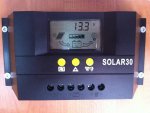What to set solar to to full charge battery's
14.4 Volts = 2.4 Volts per cell, so yes, that's about right for a vented
battery at 20 degrees C. You certainly need a lot more than 13.3V or you'll ruin the
battery pretty quickly through sulphation.
VOLTAGE: For the sake of simplicity, I am only going to talk about the requirements of standard flooded wet cell lead acid batteries, which is what most of us use. The major points apply to all types of batteries, but the actual numbers will vary. It is very important for you to research the charging requirements of your batteries if you are using any other type and make sure that your charging system provides what they need, or you could end up damaging them by over charging or never getting them fully charged, which will also damage them.
Battery manufacturer’s specifications say that a standard 12 volt wet cell
battery needs to be charged to between 14.4 to 14.8V and then held there for some time before it will be fully charged. The Trojan
Battery company says 14.8V daily charge (at 77 degrees F) and Interstate will tell you over 15V. Trojan’s 2010 Users Guide has a new chart that shows you should actually vary the voltage depending on the amps you supply for charging and even higher voltages are recommended. Of course they recommend temperature regulation. So all of those out there who are telling you 14.8V is too high do not know what they are talking about. How long it takes to get the charge in depends on how far it was discharged. Trojan says to keep charging until a hydrometer test shows that the
battery is charged and not one charger available today can do this. The best chargers can do a reasonable guess at state of charge by providing constant voltage and watching the amps taper as the
battery fills to tell them when the
battery is full. However, they rely on whatever the designer or programmer gives them for guidelines and are only as good as that data. Many do no work worth a hoot. A fully charged
battery can be maintained at a full state by applying a 13.2 – 13.6 volts “float” charge. All of the talk about how many amps a charger puts out means nothing. It is the volts (pressure) that you need to push the amps (volume) into a
battery. VOLTS, VOLTS, VOLTS!! Also, the amps pushed into a
battery at a higher voltage contain more power than those at a lower voltage. Remember, volts times amps equals watts, so amps pushed at 10% higher volts give you 10% more watts. Therefore, the power stored in the upper range of a
battery’s charge is greater, so it is very important to get a full charge. Low voltage DC is not easy to get through wire without losing power due to voltage drop or resistance. It is huge problem in an RV. Use big wires and short wiring runs to get around this. It is good practice to use one or even two sizes bigger wire than recommended to limit voltage drop. This charge voltage has to actually reach the
battery, not just the output terminals on a charger. If you cannot get your batteries up to 14.4 volts (14.8 is better & faster) with whatever charging system you have and then keep them there while pushing amps in for more than an hour or two, your batteries will never be full.


